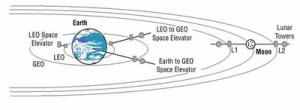Space elevatorsSpace elevator technology granted U.S. patent
Pembroke, Ontario-based space company Thoth Technology has been granted the United States patent for a space elevator. The space elevator is a freestanding space tower which is pneumatically pressurized and actively guided over its base. The company envisions a tower 20 km tall, which is more than twenty times the height of current tall structures. The space tower will be used for wind-energy generation, communications, and tourism.

Conceptual rendering of space elevator // Source: commons.wikimedia.com
Pembroke, Ontario-based space company Thoth Technology has been granted the United States patent for a space elevator. The company says that the USPTO’s Official Gazette announced the granting of the award last month.
The patent document reads: “The present invention is a self-supporting space elevator tower for the delivery of payloads to at least one platform or pod above the surface of the Earth for the purposes of space launch. The space elevator tower may also be used to deliver equipment, personnel and other objects or people to at least one platform or pod above the surface of the Earth for the purpose of scientific research, communications and tourism.”
The space elevator is a freestanding space tower which is pneumatically pressurized and actively guided over its base. The company envisions a tower 20 km tall, which is more than twenty times the height of current tall structures. The space tower will be used for wind-energy generation, communications, and tourism.
The company notes that the technology offers a new way to access space by using reusable hardware and saving more than 30 percent of the fuel of a conventional rocket.
“Astronauts would ascend to 20 km by electrical elevator. From the top of the tower, space planes will launch in a single stage to orbit, returning to the top of the tower for refueling and reflight,” said Dr. Brendan Quine, the inventor.
Thoth president and CEO, Caroline Roberts, believes the space tower, coupled with self-landing rocket technologies being developed by others, will herald a new era of space transportation.
“Landing on a barge at sea level is a great demonstration, but landing at 12 miles above sea level will make space flight more like taking a passenger jet.”
The International Space Elevator Consortium (ISEC) is holding its ISEC 2015 Space Elevator Conference in Seattle later this week (21-22 August)
The Spaceward Foundation, another organization promoting the elevator concept, says that electric vehicles, or “climbers,” could travel up and down the space tower carrying about ten tons of payload. “There are no intense gravity-loads during the trip, no acoustic vibration, no onboard fuel, nor any of the rest of the drama (and cost) associated with rocket launches,” the foundation’s engineers say.
